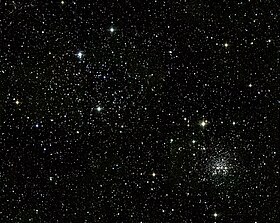Messier 35
| Messier 35 | |
|---|---|
 | |
| Observation data (J2000 epoch) | |
| Right ascension | 06h 08m 54.0s[1] |
| Declination | +24° 20′ 00″[1] |
| Distance | 2,970 ly (912 pc)[1] |
| Apparent magnitude (V) | 5.3[2] |
| Apparent dimensions (V) | 28[3] arcmins |
| Physical characteristics | |
| Mass | 1,600[4] M☉ |
| Radius | 11 ly[5] |
| Estimated age | 175 Myr[4] |
| Other designations | M35, NGC 2168,[6] Cr 82, C 0605+243 |
| Associations | |
| Constellation | Gemini |
Messier 35 or M35, also known as NGC 2168 or the Shoe-Buckle Cluster, is a relatively close open cluster of stars in the west of Gemini, at about the declination of the Sun when the latter is at June solstice.[a] It was discovered by Philippe Loys de Chéseaux around 1745 and independently discovered by John Bevis before 1750.[3] It is scattered over part of the sky almost the size of the full moon and is 2,970 light-years (912 parsecs) away.[1] The compact open cluster NGC 2158 lies directly southwest of it.
Leonard & Merritt (1989) computed the mass of M35 using a statistical technique based on proper motion velocities of its stars. The mass within the central 3.75 parsecs (12.2 ly) was found to be between 1600 and 3200 solar masses,[b] consistent with the mass of a realistic stellar population within the same radius.[7] Bouy et al. in 2015 found a mass of around 1,600 M☉ within the central 27.5' × 27.5′. There are 305 stars that can be intrinsically shown to be extremely likely to be members,[c] and up to 4,349 averaging the 50% membership probability, from the kinematic (such as parallax and proper motion) and spectral data published before 2015.[4] The cluster's metallicity is [Fe/H] = −0.21±0.10, where −1 would be ten times less metallic than the sun.[4]
Of 418 probable members, Leiner et al. in 2015 found 64 that have variable radial velocities thus are binary star systems.[8] Four probable members are chemically peculiars, while HD 41995, which in the (telescopic angular) cluster field, shows emission lines.[9] Hu et al. in 2005 found 13 variable stars in the field; at least three are suspect as cluster members. To be a member means to have a gravitational tie or, if recently freed, having been created by the same event.[10]
See also
[edit]References and footnotes
[edit]- ^ a b c d Wu, Zhen-Yu; et al. (November 2009). "The orbits of open clusters in the Galaxy". Monthly Notices of the Royal Astronomical Society. 399 (4): 2146–2164. arXiv:0909.3737. Bibcode:2009MNRAS.399.2146W. doi:10.1111/j.1365-2966.2009.15416.x. S2CID 6066790.
- ^ "Messier 35". SEDS Messier Catalog. Retrieved 23 July 2024.
- ^ a b Thompson, Robert; Thompson, Barbara (2007). Illustrated Guide to Astronomical Wonders: From Novice to Master Observer. DIY science. O'Reilly Media, Inc. p. 252. ISBN 978-0596526856.
- ^ a b c d Bouy, H.; et al. (March 2015). "Messier 35 (NGC 2168) DANCe. I. Membership, proper motions, and multiwavelength photometry". Astronomy & Astrophysics. 575: 6. arXiv:1501.04416. Bibcode:2015A&A...575A.120B. doi:10.1051/0004-6361/201425505. S2CID 73519314. A120.
- ^ Stoyan, Ronald; et al. (2008). Atlas of the Messier Objects: Highlights of the Deep Sky. Cambridge University Press. p. 160. ISBN 9780521895545.
- ^ "M 35". SIMBAD. Centre de données astronomiques de Strasbourg. Retrieved 16 November 2018.
- ^ Leonard, P. J. T.; Merritt, D. (1989). "The mass of the open star cluster M35 as derived from proper motions". Astrophysical Journal. 339 (1): 195–208. Bibcode:1989ApJ...339..195L. doi:10.1086/167287.
- ^ Leiner, E. M.; Mathieu, R. D.; Gosnell, N. M.; Geller, A. M. (July 2015). "WIYN Open Cluster Study. LXVI. Spectroscopic Binary Orbits in the Young Open Cluster M35 (NGC 2168)". The Astronomical Journal. 150 (1): 18. Bibcode:2015AJ....150...10L. doi:10.1088/0004-6256/150/1/10. S2CID 123818978. 10.
- ^ Paunzen, E.; et al. (April 2014), "Photoelectric search for peculiar stars in open clusters. XV. Feinstein 1, NGC 2168, NGC 2323, NGC 2437, NGC 2547, NGC 4103, NGC 6025, NGC 6633, Stock 2, and Trumpler 2", Astronomy & Astrophysics, 564: 8, arXiv:1403.3538, Bibcode:2014A&A...564A..42P, doi:10.1051/0004-6361/201423521, S2CID 119174151, A42
- ^ Hu, Juei-Hwa; et al. (August 2005). "Discovery of 13 New Variable Stars in the Field of the Open Cluster NGC 2168 (M35)". Chinese Journal of Astronomy and Astrophysics. 5 (4): 356–362. Bibcode:2005ChJAA...5..356H. doi:10.1088/1009-9271/5/4/003.
- ^ Hence M35 cannot be seen from the Antarctic Circle
- ^ with 95 percent confidence
- ^ have values that give a confidence of 95% or higher
External links
[edit]- Messier 35, SEDS Messier pages
- M35 – Nightskyinfo.com
- Merrifield, Michael; Rothery, Roy. "M35 – Open Cluster". Deep Sky Videos. Brady Haran.
- NASA Astronomy Picture of the Day: Mars and the Star Clusters (19 April 2006) - featured M35
- Messier 35 on WikiSky: DSS2, SDSS, GALEX, IRAS, Hydrogen α, X-Ray, Astrophoto, Sky Map, Articles and images

